Suppose the current pandemic taught us anything concerning safety and institutional living situations. In that case, we now know it is much safer to remain in a barrier-free home surrounded by familiar surroundings and friends. During the stay-at-home mandates, everyone knew what Aging in Place meant because all family members lived within this inspirational and needed solution. We all became better acquainted with our homes and family members. The best way to approach a desire to Age in Place is by being proactive before an illness takes control of your life. At that point, you must deal with it reactively. There are many differences between home modifications and a home remodel. The main difference is home modifications involve investing in your familiar home versus spending during remodeling. Home modifications enhance your ADL (Activities of Daily Living), whereas remodeling deals more with aesthetics. An example of a home modification increasing accessibility includes a walk-in tub with easy access versus an aesthetically pleasing deep soaking tub. Investing in your home using the principles of Universal Design will benefit your future retirement years by making your home gradually conform to your needs. The point of involving this universal technique in periodic remodels within your home is that the alterations appear invisible until their advantages are needed when your housing needs change. A professional CAPS program graduate performs accepted home modifications to increase accessibility for any resident.
What are CAPS services, and what does CAPS stand for? Let's be clear, it has nothing to do with hats or the associated industry. First of all, CAPS stands for Certified Aging in Place Specialist. The aging societal changes and inventory of inaccessible existing houses created the need for a CAPS certification program. This designation program, offered through the National Association of Home Builders, NAHB, in collaboration with The American Association of Retired Persons AARP, incorporates components of assessment, technical knowledge, and management skills related to proven home modifications used to help people stay at home safely and independently for a more extended time. The program was developed in 2001. The CAPS program connects responsible professionals with homeowners needing specialized accessibility services ever-increasingly. Professional CAPS services include home assessments, consultations, accessible designs, complete build-outs, accessible additions, and determining a positive path forward for any individual or their visitors requiring better accessibility and usage of their existing home, better fitting their personal needs.
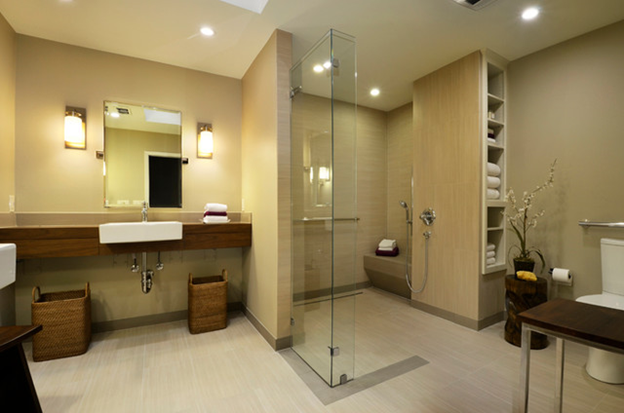
The CAPS services offered by a CAPS professional vary from a complete accessible remodel beginning at the curb and ending inside the backyard. Additionally, you can improve the comfort of the most used rooms in the home, like bathrooms, kitchens, and family rooms. The detailed process begins with a home assessment. The precise modifications identified increase usability according to the homeowner's and family's personal needs. The housing modifications are designed for all generations within a home, from children to older adults. Ordinary homeowners with extraordinary challenges partner up with experienced CAPS professionals and their own families. Working as a team, the trained CAPS specialist and any family caretakers or therapists identify the day-to-day problems weighing on those with health limitations. Aging in Place services provided by a specialized remodeling contractor ensures all accessibility issues of the home are accomplished correctly. T-Square Company, located in SW Austin, Texas, is one of the specialized CAPS certified contractors.
The CAPS credential is a nationwide initiative, and many building and design professionals are taking advantage of the helpful training nationwide. David L. Traut, president, and owner of T-Square Company, is an active CAPS member (#1636580) and has participated in the program for over a decade. Furthermore, he has actively completed accessibility design/build remodels for over three decades for the private sector, HUD, and the VA. Always check a person's credentials to verify the remodeler holds an active CAPS certification and is familiar with Universal Design. All registered CAPS program graduates and remodeling companies are listed in a national registry in Washington, DC. The information is found by calling 1-800-368-5242 or simply visiting their website at: http:www.nahb.org/en/learn/designations/certified-aging-in-place-specialist.aspx.

T-Square Company in SW Austin, Texas, located at 14141 Highway 290 West, Suite 800, is a CAPS-certified remodeler and offers design/build Aging in Place projects using principles of Universal Design. Call 512-444-0097 to discuss your project today and learn how to achieve better accessibility within your existing home. Our knowledge and experience can help solve your personal needs within your existing home. Whether you need a safer shower, wider doorways, a zero-step entrance, or a more accessible kitchen to entertain your family and friends, T-Square Company is here to help.
Tags:
barrier free access,
aging in place remodeling,
CAPS,
aging in place home modifications,
ADA compliance,
custom tub to shower conversions,
accessible home remodeling,
CAPS remodeling techniques,
aging in place services,
bathroom modifications for disabled,
ADA bathroom Austin, Texas,
home modifications for independent living Austin,
Austin Handicap Remodeling,
universal design ideas,
certified aging in place consultant in Austin,
universal design remodeling contractor,
handicap accessible remodeling,
barrier free remodeling,
disability remodeling,
handicap accessible bathroom shower,
veterans home remodeling in Austin, Texas,
veterans home accessibility help in Austin, Texas,
accessible toilets,
ADA Compliant grab bars,
home access,
what is aging in place,
accessible home builder in Austin,
ADA Compliant Bathroom Vanity,
the basics of aging in place,
universal design home additions,
CAPS-certified remodeling in Dripping Springs,
Dripping Springs home accessibility solutions,
Dripping Springs kitchen remodel,
Dripping Springs bathroom remodel,
Dripping Springs TX home modification services,
Dripping Springs home modification services,
Dripping Springs bath remodeling,
Dripping Springs senior home remodeling,
Dripping Springs special needs contractor,
Dripping Springs aging in place specialist
What are CAPS services and what does CAPS stand for? First of all, CAPS stands for Certified Aging in Place Specialist. The aging societal changes and inventory of inaccessible existing houses created the need for a CAPS certification program. This designation program, offered through the National Association of Home Builders, NAHB, in collaboration with The American Association of Retired Persons or AARP, incorporates components of assessment, technical knowledge, and management skills related to home modifications used to help people stay at home safely and independently for a longer period of time. The program was developed in 2001.
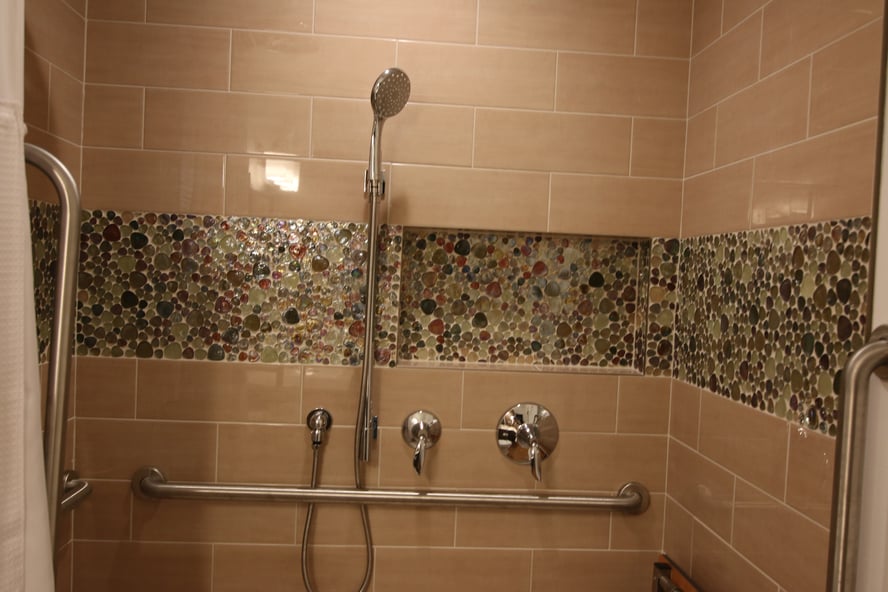
The services offered by a CAPS professional varies from a complete accessible remodel to improving certain areas in the home like bathrooms or kitchens. The precise modifications increase usability according to personal needs of the homeowner and family. The CAPS program connects responsible professionals with homeowners needing specialized accessibility services on an ever-increasing basis. Ordinary homeowners with extraordinary challenges partner up with experienced CAPS professionals and their own families. Working as a team, the trained CAPS specialist along with any family caretakers or therapists is able to identify the day-to-day problems weighing on those with health limitations. Aging in Place services provided by a specialized remodeling contractor ensures all accessibility issues of the home are accomplished correctly. T-Square Company located in Austin, Texas is one of the specialized CAPS certified contractors.
The CAPS credential is a nationwide initiative and many construction and design professionals are taking advantage of the helpful training across the nation. David L. Traut, president, and owner of T-Square Company is an active CAPS member (#1636580) and has participated in the program for over a decade. Furthermore, he has actively completed accessibility design/build remodels for over 25 years for the private sector, HUD, and the VA. Always check a person's credentials to verify the remodeler holds an active CAPS certification and is familiar with Universal Design. All registered CAPS program graduates and remodeling companies are listed in a national registry in Washington DC. The information is found by calling 1-800-368-5242 or by simply visiting their website at: http:www.nahb.org/en/learn/designations/certified-aging-in-place-specialist.aspx.

If the current pandemic taught us anything concerning safety and institutional living situations, we now know it is much safer to remain in your home surrounded by familiar surroundings and friends. During the stay-at-home mandates, everyone was aware of what Aging in Place meant. We all became better acquainted with our homes and family members. The best way to approach a desire to Age in Place is by being proactive before an illness takes control of your life. At that point, you must deal with it in a reactive manner. There are many differences between home modifications and a home remodel. The main difference is home modifications involve investing in your familiar home versus spending during remodeling. Home modifications are used to enhance your ADL (Activities of Daily Living) whereas remodeling deals more with aesthetics. Investing in your home will benefit your future retirement years by making your home conform to your needs.
T-Square Company in Austin, Texas is a CAPS certified remodeler and offers design/build Aging in Place projects using principles of Universal Design. Call 512-444-0097 to discuss your project today and learn how you can achieve better accessibility within your existing home. Our knowledge and experience can help solve your personal needs within your existing home. Whether you need a safer shower, wider doorways, a zero-step entrance, or a more accessible kitchen to entertain your family and friends, T-Square Company is here to help.
Tags:
barrier free access,
aging in place remodeling,
CAPS,
aging in place home modifications,
ADA compliance,
custom tub to shower conversions,
accessible home remodeling,
CAPS remodeling techniques,
aging in place services,
bathroom modifications for disabled,
ADA bathroom Austin, Texas,
home modifications for independent living Austin,
Austin Handicap Remodeling,
universal design ideas,
certified aging in place consultant in Austin,
universal design remodeling contractor,
handicap accessible remodeling,
barrier free remodeling,
disability remodeling,
handicap accessible bathroom shower,
veterans home remodeling in Austin, Texas,
veterans home accessibility help in Austin, Texas,
accessible toilets,
ADA Compliant grab bars,
home access,
what is aging in place,
accessible home builder in Austin,
ADA Compliant Bathroom Vanity,
the basics of aging in place,
universal design home additions
When mobility becomes an issue for any homeowner, regardless of age, the question arises concerning physically moving to a different home with a bath that is more accessible. Preparing for one of those highly likely events involving someone in your home needing room modifications for even a short time while recovering from surgery is surely a smart move. Solving aging in place issues will soon become the number one challenge concerning the present obsolete housing inventory in our country. Our present day obsolete homes now inhabited by the baby boomer generation will slowly and increasingly raise their outdated and obsolete ugly heads and expose their true lack of kitchen or bathroom accessibility to those very people inhabiting them. The situation will only become ever more expanding in time. When these homes were previously purchased, they represented an absolute castle in the world of their owners in which to prepare for a day and they also acted as a retreat from life's tough interactions. They housed our families, our memories, and our stuff. They represented a place where we could be ourselves. Our homes have always been exempt from any and all of the accessibility regulations that have been put in place since 1968 when our Viet Nam veterans were returning home.
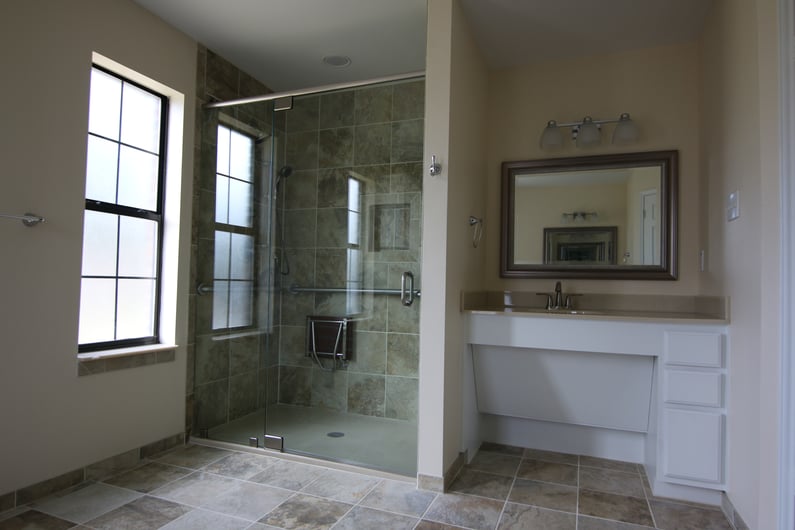
The new evolving concept known as Universal Design and specialized handicap remodeling contractors for home access remodeling is catching on nation wide and has been for several years as a sign of the times. Universal design techniques used in building makes a home more accessible to all regardless of their mobility or adaptive abilities. An evolution of new products used for disability home modifications is making those homes more accessible and has finally come about in the remodeling industry. These new advances in accessible home remodeling in Austin not only keep the living environments safer but will not compromise the home's aesthetics. In fact, there are many benefits to using universal design techniques, including potential use by aging family members, added resale value, and the fact that you'll be creating a space that can be used by anyone who visits your home, regardless of their range of abilities. Simple universal design updates for aging in place home modifications and handicap bathroom accessibility can include adding grab bars or handrails throughout the home, adding a seat within the roll in shower, lowering upper cabinets and counter tops, adding non-slip flooring, widening hallways or installing stair lifts, and widening doors. Many people find themselves needing accessible homes for themselves or family members. There are approximately 30 million Americans using wheelchairs and the number of people who need accessible homes will continue to increase as disabled and aging people are finding more ways to remain living in their homes. One important way to increase independent living is making a home accessible to an individuals personal needs. Home modifications can increase safety, accessibility, and independence for people who want to live independently.

The National Association of Home Builders, in partnership with the AARP and Home Innovation Research Labs, created the CAPS program, which includes training and education on the technical, business management and customer service skills essential to compete in the fastest growing segment of the residential remodeling industry--home modifications for aging in place and ADA accessibility in Austin, Texas. David L. Traut, CAPS the owner of T-Square Company in Austin, Texas is one of the select group of professionals nationwide to earn the Certified Aging-In-Place Specialist (CAPS) designation, identifying him as a home remodeler and builder with the skills and knowledge necessary to remodel or modify a home to meet the unique needs of the older population, disabled owners, or their visitors.
If you ever find yourself needing better accessibility within your home during a recuperation or as a general more permanent need please don't hesitate to reach out to me directly.
Sincerely,
David

Tags:
residential general contractor Austin, Texas,
home accessibility help in Austin,
home remodeling for disabled in Austin Texas,
wheelchair accessible home remodeling in Austin,
universal design remodeling contractor,
principles of universal design,
Austin Senior Home Remodeling,
disability contractor in Austin,
disability and special needs contractor Austin,
home modifications for elderly in Austin,
bathrooms with disability access in Austin, Texas,
Austin disability contractors for special needs,
Austin handicap bathroom contractor,
handicap accessible remodeling,
handicap remodeling,
handicap accessible home renovations,
disability remodeling,
handicap accessible bathroom remodel,
handicap accessible bathroom shower,
ADA compliant wheelchair accessible showers,
disability access contractor,
home modifications for Austin veterans,
veterans home accessibility help in Austin, Texas,
ADA compliant roll in showers,
wheelchair accessible shower stalls,
accessible bathroom design specifications,
accessible toilets,
barrier free toilets,
ADA vanity height,
ADA Compliant grab bars,
professional remodeling contractor,
professional remodeler,
disabled bathroom remodel,
accessible bathroom remodel,
specialty construction in Austin,
home remodeling contractor residential,
home access,
accessible homes,
what is an ADA compliant bathroom,
home access in Austin
A bathroom designed for someone who is aging in place is very different than one based on aesthetics or home value. Remodeling when considering future needs requires intuitive thought and considerations before you begin. The issues to consider include a safe design having ease of use by everyone and the people who will be using the facilities. Remember that remodeling a bathroom will take time and effort and there will be costs involved. When someone wants to age in place it is worthwhile to explore a universal design bathroom design that is both comfortable and safe to use as the occupant’s personal needs change. The bathroom is one space in the home where safety is of the utmost importance. From the toilet, to the shower, the vanity, and onto the lighting, there are adaptations and products to help keep the bathroom a safe place for all.
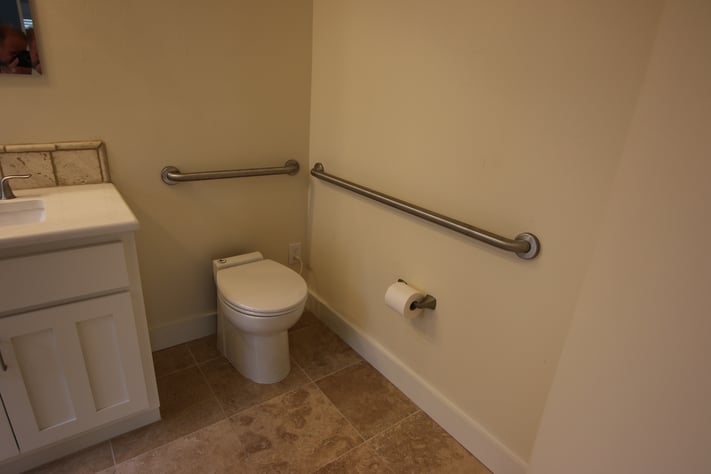
The goal of an accessible bathroom design is to make the bathroom a safe space for everyone who uses the facilities. Aging in place services use universal design to accommodate wheelchair use and can make the bathroom more comfortable for all generations with or without specific needs. It is important to carefully outline the scope of work during the remodeling of an accessible bathroom by first taking inventory of the users capabilities, needs, and preferences. All disability home remodeling or disability bath remodels must be done considering all the data provided by the client, his or her family, and any caretakers involved. Aging in place design must be carried out by an aging in place specialist holding a CAPS certificate. Only an experienced qualified remodeler holding a CAPS certificate has the qualifications to design an accessible route and perform the construction required to make it safe and functional for the AIP customer. Accessible bathrooms with custom walk in showers and kitchens are available using the right education and experience. Never consider hiring a "jack of all trades but master of none" type handyman to tear your bathroom apart. What's more, you certainly do not want to witness such a person struggling to piece the room back together attempting to achieve your long desired bathroom remodel idea. If so, you will absolutely learn a hard and invaluable lesson in getting what you pay for by accepting the handyman's cheapest bid.

In 1990, The Americans With Disability Act (ADA) set forth the guidelines for accessibility within public and commercial buildings. We use these same guidelines today when designing for people's increased accessibility within their home since no laws exist for the residential marketplace. Most of the requirements are merely common sense when universal design techniques are practiced. For instance, the standards for toilets regulate the height, the clearance in front and to the sides, the positions of grab bars and toilet paper holders, and the operation of the flush mechanism.
The height of a standard toilet is 17 inches or lower with 14 1/2 inches being the common height. The ADA guidelines mandate a distance between 17 and 19 inches from top of the seat to the floor on a handicap toilet. If the toilet is for use by children the height must be between 11 to 17 inches. The flush control is required to be on the open side of the toilet and should have easy one hand operation.
If you're designing a bathroom for handicapped use, implementing ADA standards within the design make it easier for wheelchair bound people to maneuver around the toilet. Consider the placement of the toilet in relation to walls and barriers in the bathroom. Having a clear floor space with at least 48 inches between the walls on either side of the toilet to make it easier to negotiate the approach. The toilet should be positioned a distance of 18 inches from one of the walls to create an approach space on the opposite side of the toilet. If the lavatory is situated on a side wall it must be placed at least 18 inches from the toilet. Space requirements in front of an ADA toilet vary according to the placement of the toilet, but in general, you need about 66 inches from the back wall to the wall opposite the toilet which is almost standard in a bathroom dictated by the width of a standard tub. A clear five foot turning radius should be observed for maximizing wheelchair operations. Grab bars are required in all ADA compliant bathrooms or toilet stalls. You should provide them behind the toilet and on the side walls and they should be 33 to 36 inches above the finished floor. The grab bar lengths should be twenty four to thirty six inches behind toilet and forty two to forty eight inches on the side wall with the bar located two feet from the front of the toilet. Folding grab bars can be used when the side wall isn't sufficient and they fold up for convenient out of the way storage.

Tags:
applying principles of universal design in Austin,
home remodeling for seniors Austin,
Austin Senior Home Remodeling,
remodeling for elders in Austin,
home remodeling for the elderly,
disability contractor in Austin,
special needs contractor in Austin,
disability and special needs contractor Austin,
senior home modifications in Austin,
home modifications for elderly in Austin,
bathrooms with disability access in Austin, Texas,
Austin disability contractors for special needs,
Austin handicap bathroom contractor,
handicap accessible remodeling,
barrier free remodeling,
handicap remodeling,
handicap accessible home modifications,
handicap accessible bathroom remodel,
handicap bathroom remodel,
disability access contractor,
accessible home remodeling for disabilities,
home modifications for Austin veterans,
veterans home remodeling in Austin, Texas,
veterans home accessibility help in Austin, Texas,
barrier free showers in Austin,
accessible bathroom design specifications,
accessible toilets,
wheelchair accessible toilets,
barrier free toilets,
handicap accessible toilets,
ADA Compliant grab bars,
ADA compliant grab bar height
No matter how old you are you should periodically evaluate your residence to determine whether it suits you not just for the present but the future. Your home assessments will be rethought every time your living situation changes. Whether childproofing for a newborn, making a home more accessible following a sickness or unfortunate accident to someone in the family, or making a toilet area safer for an aging residing parent, there will be an immediate evolution to your primary domicile. These same life span design features are even more important if you believe you're past the age of wanting to move and are relishing the thought of aging in your own home, no matter what physical limitations you might later develop. Incorporating smart aging design concepts into a home will attract a larger group of buyers when you decide to finally sell your home.
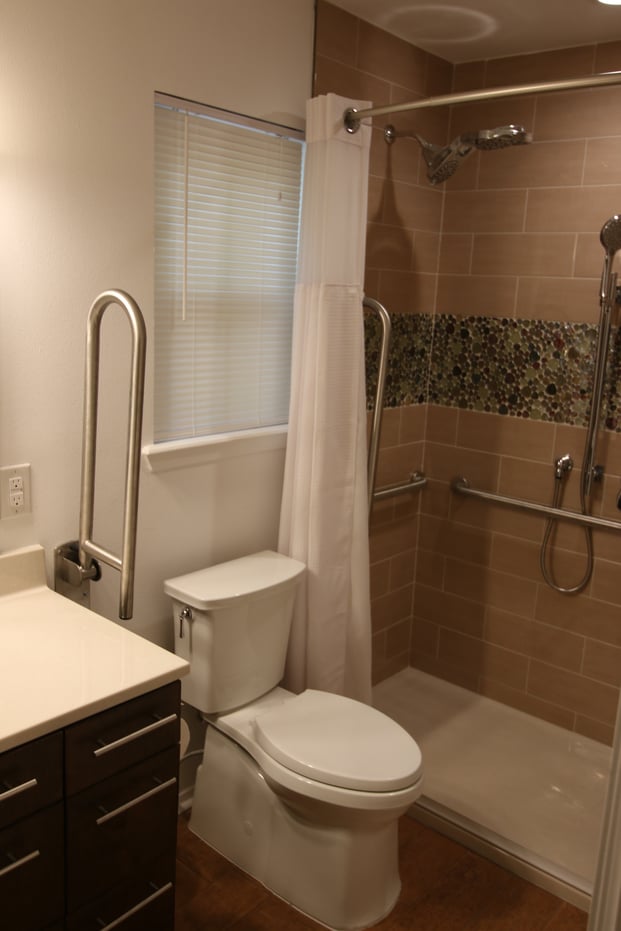
When mobility becomes an issue for any homeowner, regardless of age, the question arises concerning physically moving to a different home with a bath that is more accessible or making the existing home modifications which will meet the need of the new life changes.Solving aging in place issues will soon become the number one challenge concerning the present obsolete housing inventory in our country. Our present day obsolete homes now inhabited by the baby boomer generation will slowly and increasingly raise their outdated and obsolete ugly heads and expose their true lack of kitchen or bathroom accessibility to those very people inhabiting them. The situation will only become ever more expanding in time. When these homes were previously purchased, they represented an absolute castle in the world of their owners in which to prepare for a day and they also acted as a retreat from life's tough interactions. They housed our families, our memories, and our stuff. They represented a place where we could be ourselves. Our homes have always been exempt from any and all of the accessibility regulations that have been put in place since 1968 when our Viet Nam veterans were returning home. The new evolving concept known as Universal Design and specialized handicap remodeling contractors for home remodeling is catching on nationwide and has been for several years as a sign of the times. Universal design techniques used in building makes a home more accessible to all regardless of their mobility or adaptive abilities.
Many people find themselves needing accessible homes for themselves or family members. There are approximately 30 million Americans using wheelchairs and the number of people who need accessible homes will continue to increase as disabled and aging people are finding more ways to remain living in their homes. One important way to increase independent living is making a home accessible to an individual’s personal needs. Home modifications making homes wheelchair accessible can increase safety, accessibility, and independence for people who want to live independently.

Falls and slips are among the most common causes of injury to senior or elderly people and for those with a disability. Smooth surfaces in combination with wet areas make the bathroom one of the most dangerous areas within the home. It is of paramount importance that the bathroom be updated providing safety for any person with limited mobility or the elderly. Grab bar installation will greatly improve safety and usability of the bathroom.
If the residence is fairly new and uses universal design techniques or the geographic area uses accessible housing standards, the walls in the tub area and the walls behind and next to the toilet should have extra blocking. Blocking is a structural reinforcement within a wall that allows a grab bar to be attached securely to withstand a 250 pound force. Studs can also be used but may not be located in the most desirable location for the length of the grab bar being used. The purpose of a grab bar is to help support a person, and the grab bar must be able to support a person's weight until help arrives or the person can right themselves. A grab bar is both pulled and pushed against.The standard size for a grab bar is 1-1/4 to 1-1/2 inches in diameter and should be 1-1/2 inches away from the wall. With some new construction, blocking is placed in the walls such that grab bars can be installed easily at a later date when needed. If there is no blocking in the walls, it can be added later but the wall must be open up to expose the studs. The recommended type is 3/4 inch plywood, 6 to 12 inches wide and nailed into the studs or a 2 by 6 or 8 inch block nailed into the studs. Today, grab bars come in many metal finishes and decorative shapes. Contrasting colors are easier to see in an emergency. Grab bars with a slight milled in texture are easier to grip. The blocking should be the full length of the tub and at both ends. This allows grab bars to be installed anywhere in the area or in more than one place. Never install grab bars on an angle where wet hands can slip. Grab bars should exist on all sides of the shower and tub walls. At the toilet, the blocked areas should be behind the toilet and on at least one side. If there is no wall next to the toilet, an L-shaped grab bar can be installed by attaching the front end to the floor and the back to the wall behind the toilet. All grab bars should be installed at the universal height of 34-36 inches above the finished floor. Folding grab bars can be used when adjacent walls don't exist in a 24" reach distance for a seated person.

Once the demands of our built environment exceed their capacities we become excluded from a room or even the entire home. The building world must work in unison to be sure the entire living environment meets basic needs in addition to affordability and structural integrity for the consumer and home owner. This includes both the home and the components within the home being accessible to all inhabitants. Privacy, sense of belonging, sense of control, and the sense of safety and security make up the quality of life for any home and should be considered for any design. Universal Design is where we are headed out of necessity.
Tags:
age in place home design,
what does it mean to age in place,
universal designbuilding for the future,
residential general contractor Austin, Texas,
home accessibility help in Austin,
home remodeling for disabled in Austin Texas,
wheelchair accessible home remodeling in Austin,
universal design remodeling contractor,
universal principles of design,
applying principles of universal design in Austin,
remodeling for elders in Austin,
disability contractor in Austin,
special needs contractor in Austin,
disability and special needs contractor Austin,
senior home modifications in Austin,
home modifications for elderly in Austin,
bathrooms with disability access in Austin, Texas,
Austin disability contractors for special needs,
Austin handicap bathroom contractor,
handicap accessible remodeling,
barrier free remodeling,
handicap remodeling,
handicap accessible bathroom remodeling,
handicap accessible home renovations,
handicap accessible home modifications,
disability remodeling,
handicap accessible bathroom remodel,
Austin aging in place specialist,
handicap access bathroom remodel,
handicap accessible bathroom shower,
handicap bathroom remodel,
ADA compliant wheelchair accessible showers,
roll in shower design for wheelchair access,
disability access contractor,
accessible home remodeling for disabilities,
home modifications for Austin veterans,
veterans home remodeling in Austin, Texas,
veterans home accessibility help in Austin, Texas,
barrier free showers in Austin,
ADA compliant roll in showers,
handicap ADA roll in shower,
wheelchair accessible shower stalls,
roll in shower,
accessible bathroom design specifications,
wheelchair accessible toilets,
handicap accessible toilets,
ADA Compliant grab bars,
ADA compliant grab bar height
















